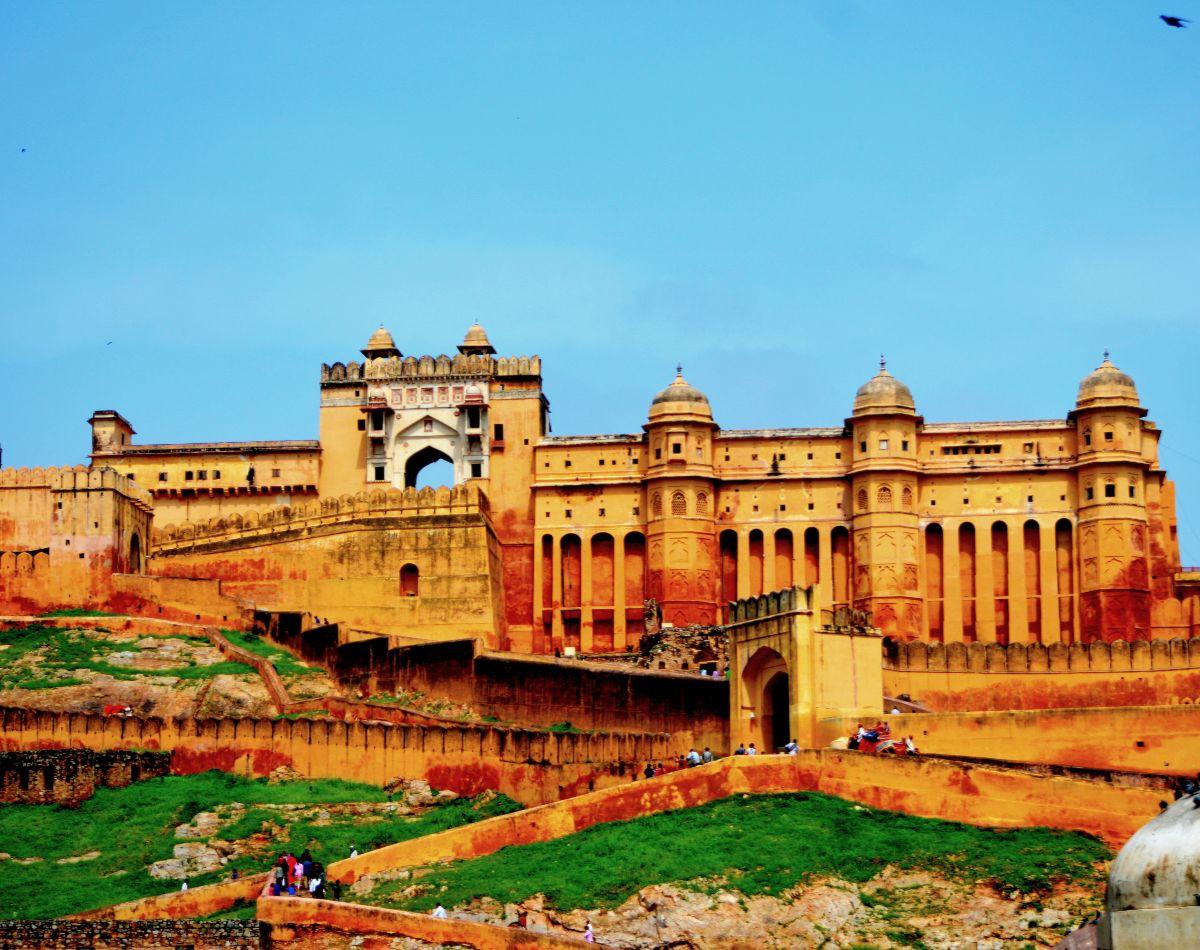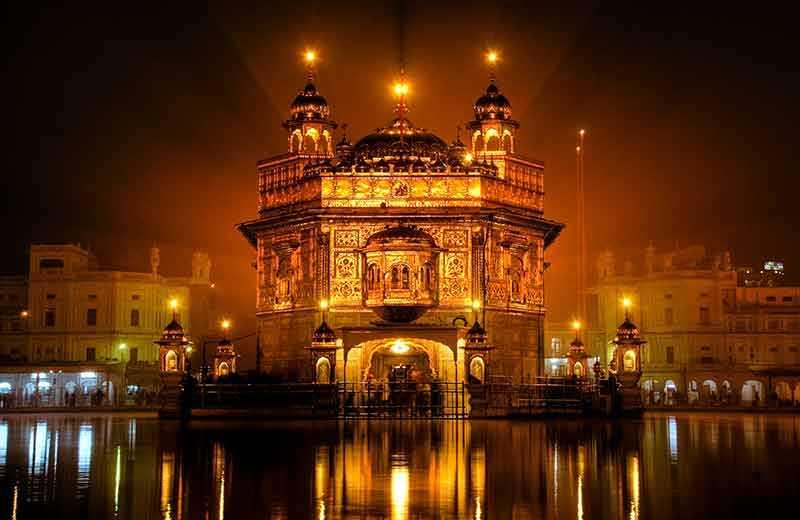Kashmir Travel Guide

Beauty of Kashmir
If you are searching for evidence of truth in the phrase 'Heaven on Earth,' this is a great place to look. Start by visiting the region of Kashmir, also known as 'Paradise on Earth' – a stunning area located in the north of India. Kashmir is a magical kingdom with a unique geography, with exposure to snowy–top mountains and transparent lakes.
The broad valleys are painted with the pretty colours of blossoming flowers, and the rivers and the streams trace their dramatic paths through the emerald valleys, like something from fairy tales.
For every shading of the land, there is a unique beauty of the region: the chills of spring with colours of flowers, the scorching summer that offers a retreat from central India heat, the valleys golden and red from the autumn trees, and the Kashmir of winter – a blanket of snow.
However, Kashmir's beauty is not only natural and the landscape. This region is about culture and history; tourists can always be interested in the moments here.
What does Kashmir offer to Travelers?
It is a multiculturally diverse place where locals are always happy to receive visitors and introduce them to the culture and traditions of the region. Walk around the markets in Srinagar, and you will see acceptable jewellery items, clothes made from pure pashmina shawls, beautiful carpets, etc.

You can visit the famous Mughal gardens, with well-tended lawns and rushing fountains on water bodies, or cruise in well-decorated Shikaras amidst the majestic Himalayas on the Dal Lake.
Whether you're into adventures or more of a naturist, the valley's tranquillity, the locals' hospitality, and Kashmir's beauty will make you go 'Wow'.
Why do people love Kashmir?
Many fall in love with Kashmir due to the stunning natural beauty and picturesque setting that seems so unreal, it might seem like a scene from a fairytale.
As you see the scenic mountains and hills, the crystal clear waters of the Dal or Wular lake, and the Pir Panjal range's snow-white slopes, you fall in love with this natural paradise.

The vales of spring with flowers add a distinct colour to the valleys; thus, the serene water of Dal Lake and the white sheet of snow add to the beauty of the place.
In addition to the picturesque, stunning scenery, the people over the bridge are lovely and hospitable, and, uniquely, their culture feels very close-knit.
If one wants to taste the tranquillity and beauty of this world, one will find that this enchanting paradise has lots to offer in terms of peace, adventure, and inspiration in every part of Kashmir.
About Kashmir Tourism
The golden era of Kashmir tourism was when the place was one of travellers' favourite spots worldwide. After the mid-1900s, the region received many tourists worldwide owing to its natural beauty, good climate, and rustic cultural values.
Houseboats on Dal Lake were fascinating, as they made the accommodation very homely while giving visitors a peek into the life of the people.

Many visitors visited the famous LOC Mughal gardens, marvelous historic shrines, and vibrant moments at the bazaars to discover their historical richness.
Fishing in its beautiful rivers, skiing in Gulmarg, and trekking in the Himalayas are some activities that enticed tourists to make Kashmir a desired place. Nevertheless, the last decades of the twentieth century saw decreased popularity among tourists because of political instability and security issues.
People visit the streets and markets less, and many companies connected with tourism suffer from a decline in clients; measures are being taken to reconstruct tourism, for instance, infrastructural development and security issues.
However, the situation is changing today, and the situation regarding tourism in Kashmir is gradually coming out of the troubled phase. The area is again on the map for adventurers, nature and culture buffs, or travellers.
Houseboats and Shikara rides in Dal Lake are getting their lost charm back, and other attractions include eco-tourism, winter sports, etc. The efforts put forth by the government to persuade Kashmir to be a safe and beautiful place for tourism are slowly and steadily reviving its beauty, and it is on the list of every traveler’s place to visit.
Kashmir Elevation
Geographically, Kashmir has a splendid altitude varying between approximately 1,620 meters in the valley and 4,877 meters above sea level in the cliffs and mountains encircling the valley.
This topography feature produces beautiful scenery, from the valley greenery to the snowcapped mountain. The valley is, on average, 5,300 feet above sea level and has a temperate climate, attracting tourists all year.
Skiing and other winter sports are possible in places such as Gulmarg, with higher altitudes; on the other hand, the alpine meadows and high-altitude lakes are suitable for trekking and other nature-related activities in warm seasons.
Best Time To Visit Kashmir
The best time to visit Kashmir is a question that can be answered because it depends on the kind of climate that one is comfortable with while visiting a place. The spring season is from March to May, and the special time to visit Srinagar is when the tulip gardens blossom and enhance the beauty of the weather.
It is neither too hot nor too cold for most of the year, offering good visibility for tourists to go sightseeing and engage in other outdoor activities, especially the famous Tulip Festival held every April.
The monsoon starts in June and continues until August, but Kashmir offers a cooler climate than the rest of India. Trekking and camping can be done in Kashmir due to its mild weather, which ranges from 15 to 30 degrees Celsius. This makes it perfect for visiting places such as Gulmarg and Pahalgam. This is the best time to do adventure sports and enjoy the area's beautiful scenery.
The autumn season shows natural colours such as orange, yellow, and red, particularly in Srinagar and Pahalgam. The warm and sunny weather provokes a favourable response to travel and photo opportunities; the vivid chinars (maple trees) add beautiful colours to the shots.
Winter, specifically December to February, transforms the landscape into snow-covered spaces and may suit those who love winter sports. The region transforms into a wonderland, especially in the winter.
After that, it became a fine place for winter activities, such as skiing and snowboarding in places like Gulmarg. However, winters are severe, with heavy snowfalls resulting in possible disruptions of transport, and as such, visitors should expect cold weather with probable disruptions.
Places To Visit In Kashmir
Kashmir is known for its astonishing landscapes, rich culture, and vibrant heritage. Here are some of the best places to visit in Kashmir, each offering a unique experience:
1. Srinagar
Srinagar is the summer capital of Jammu and Kashmir and is well known for gardens, houseboats, and colourful markets. Shikaras, the typical houseboats, and riding on the Dal Lake must not be missed. Gardens like Shalimar Gardens and Nishat Gardens are wonderful scenes that depict the beauty of design and flowers.
2. Gulmarg
Gulmarg, known as the 'Meadow of Flowers, ' is a famous hill station and skiing resort. It is filled with colourful flowers in summer, and in winter, it is covered in beautiful snow. The Gulmarg Gondola, considered among the highest cable cars globally, offers tourists stunning views of the Himalayan range.
3. Pahalgam
Pahalgam is a beautiful place on the River Lidder's banks and the Sheshnag Lake's doorstep. Popular for its beautiful valleys of green pastures and eye-catching scenery, it marks the beginning point of the Amarnath Yatra. For nature lovers, hiking, camping, and fishing facilities are available in this beautiful area.
4. Sonamarg
Sonamarg translates as the meadow of gold, with splendid meadows and glaciers. Located in the lap of snow-clad mountains, it is well known for trekking and various adventure sports. Thajiwas Glacier is nearby, and its primary attractions are the snow activities and beautiful scenery.
You will see:
5. Dal Lake
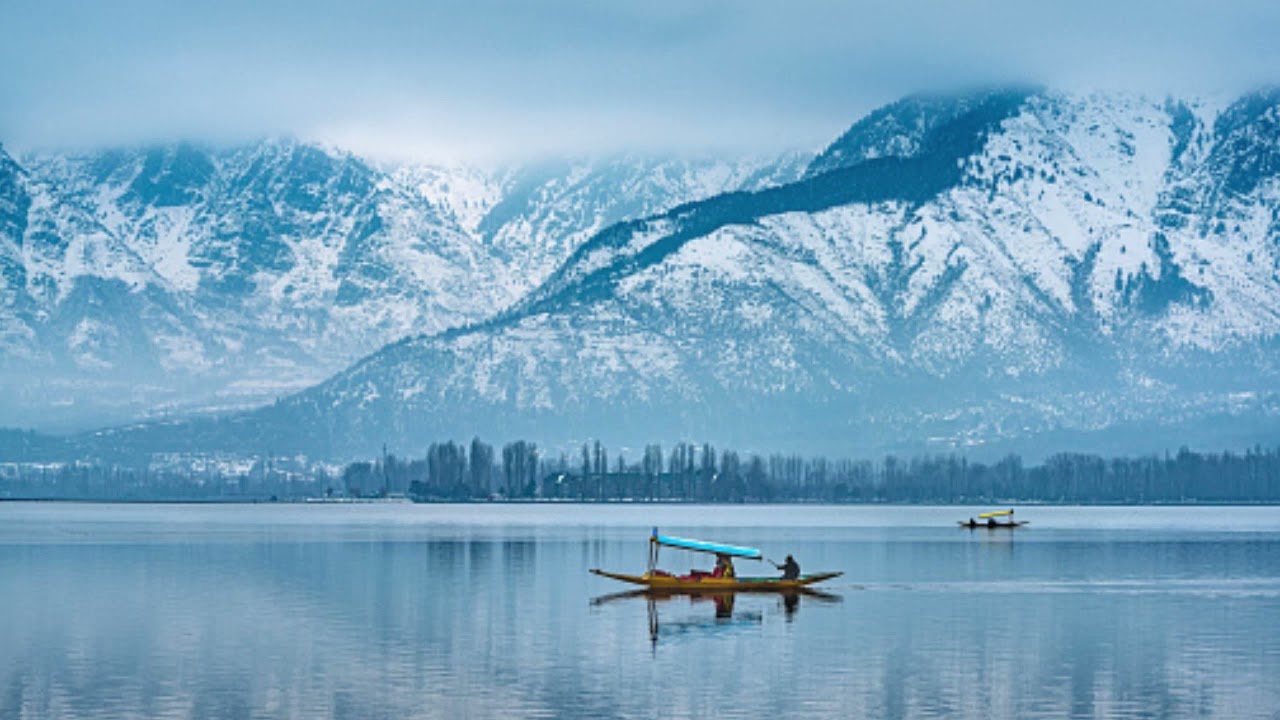
Among all the beautiful lakes, one of the most famous and frequently called the Jewel in the Crown of Kashmir is the Dal Lake. It is famous for its houseboats and floating gardens. Tourists can boat along the Dal Lake in a Shikara boat and be delighted with the Zabarwan Mountains' backdrop.
6. Kashmir Valley

The Kashmir valley is a striking paradise with beautiful villages, large greenfield areas, and snow-white mountains. Some of the scenic places of interest are Anantnag and the well-known fringe town of Awantipora, which provides a thrilling view of the valley's diverse traditions.
7. Shankaracharya Temple
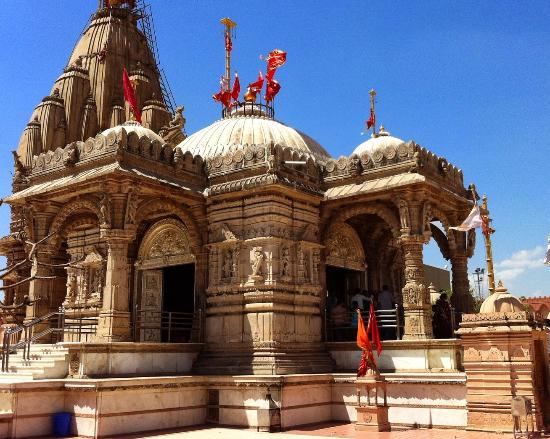
This is a very old Hindu temple for Lord Shiva situated at Shankaracharya Hill, Srinagar. The temple's hilltop location provides a picturesque view of Srinagar and Dal Lake. Religious groups revere it, and it has stunning architecture, including a structure from the early 9th century.
8. Yusmarg
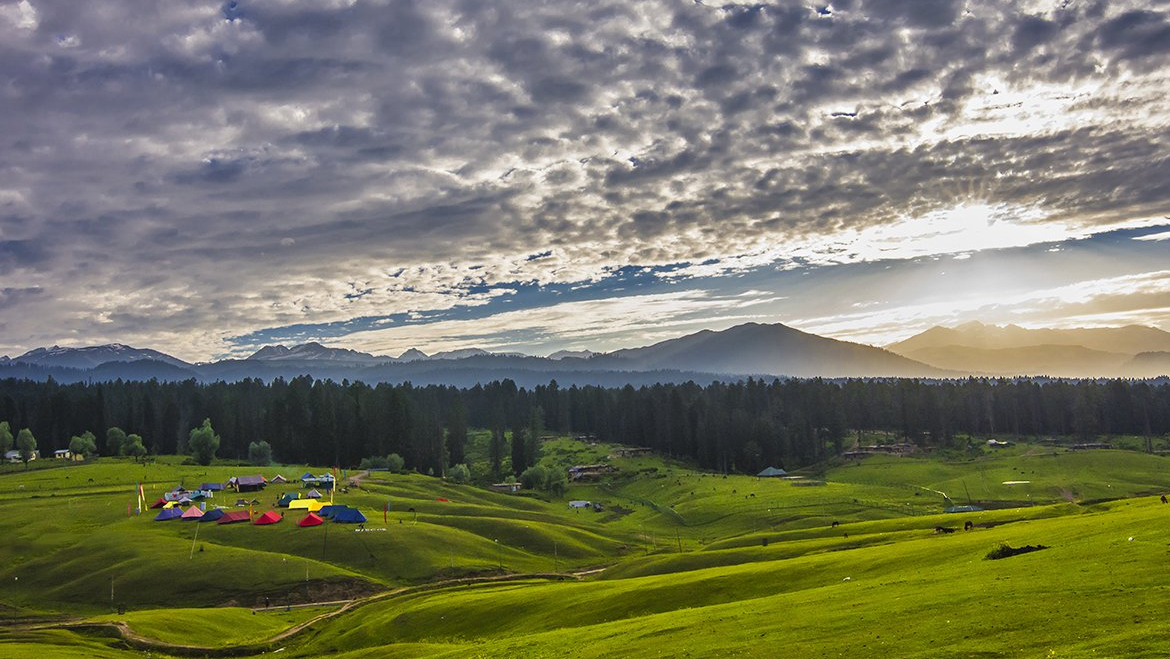
Yusmarg, meaning "Meadow of Jesus," is a lesser-known gem in Kashmir. Surrounded by dense forests and lush meadows, this tranquil destination is perfect for picnics, nature walks, and relaxing in serene surroundings. The nearby Doodganga River adds to its charm.
9. Aharbal
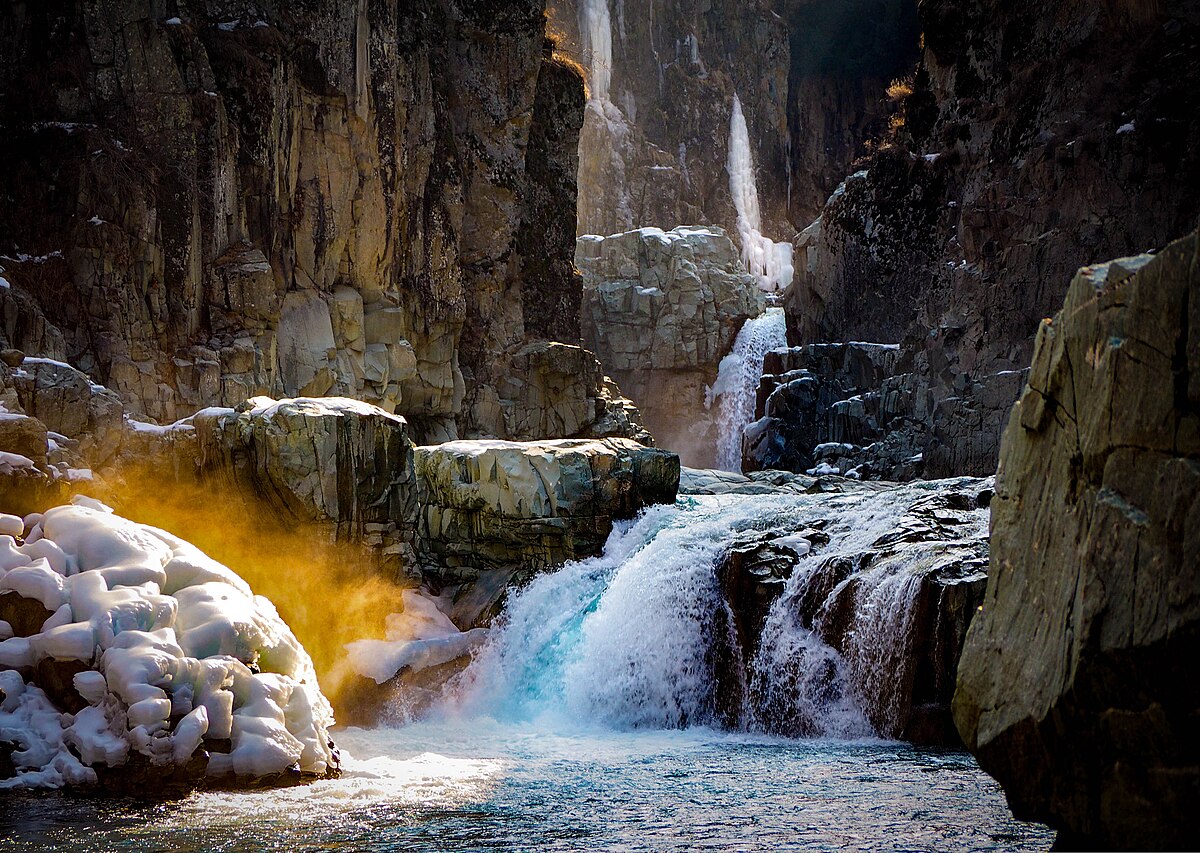
Aharbal is known for its stunning waterfall and picturesque landscapes. Located on the Vishav River, the waterfall cascades down a rocky terrain, creating a beautiful sight. The area is perfect for nature lovers and offers opportunities for trekking and fishing.
10. Nubra Valley
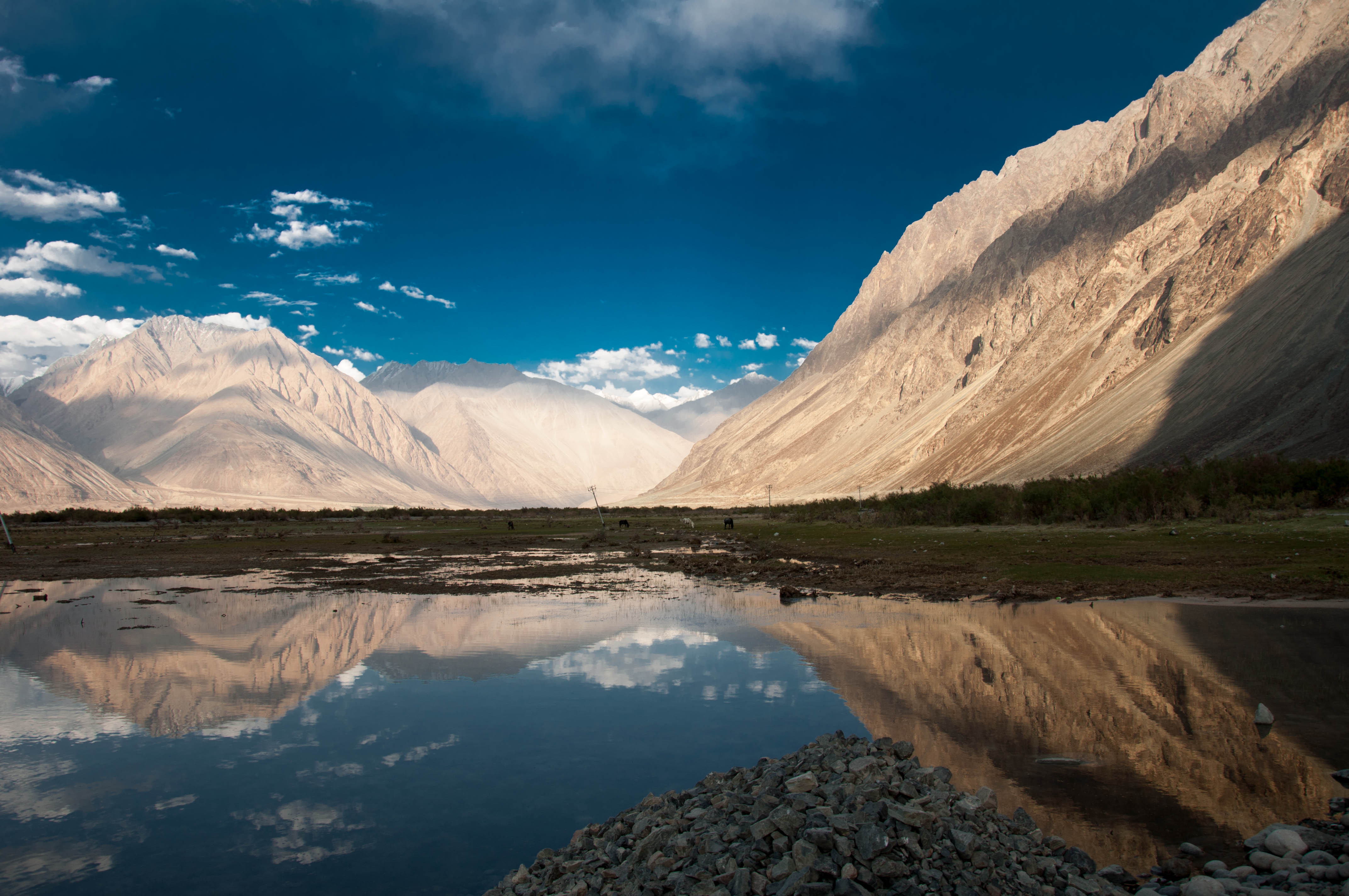
Nubra Valley, accessible via the Khardung La Pass, is famous for its unique landscapes, including dunes and hot springs. The valley is home to the double-humped Bactrian camels and offers stunning views of the surrounding mountains. The Diskit Monastery, with its giant Buddha statue, is a must-visit.
How is Kashmir Throughout The Year
Kashmir in January
January is the peak winter in Kashmir, and therefore, the climate is chilling, with average temperatures of -2-8 degrees Celsius in January. This area is a winter wonderland, where the ground is most often covered with snow, as seen in the picture.
This is also the appropriate time for snow-related sporting activities such as skiing, especially in Gulmarg, and marvel at the white scenery. However, travellers should be ready to face the severe cold, and in some parts, there may be no roads due to the accumulated snow.
Kashmir in February
February is relatively cold because the average temperatures lie between -1°C and 10°C this month. The climate remains cold now, with snow still on the ground, and the area is still a favourite for winter sports lovers.
Skiing and snowboarding enthusiasts are out in full force, thronging to Gulmarg. From a scenic point of view, it is beautiful, especially when there is fresh snow on the ground; it is a lovely sight that attracts many people who love winter.
Kashmir in March
March is the beginning of spring; temperatures are relatively higher than in winter, recorded between 3 ° C and 15 ° C. When it starts to snow, people wear warm coats. Slowly, the snow melts to green coverage.

This is a good time to visit as the area begins to come to life, especially the tulip gardens at Srinagar, which look forward to the flowering season. It is often warm to hot and dry, which is perfect for many endeavours of the outdoor sort.
Kashmir in April
April is a lively month in terms of weather, with temperatures between 7 and 20 ° C. This is when the tulips in Srinagar bloom, adding charm to the scenic beauty.
The climate is mostly warm and sunny, thus conducive to sightseeing and viewing the gorgeous scenery. This is one of the best seasons to visit the area since the natural view is at its best at this time.
Kashmir in May
March to May are good months for warm weather, ranging between 10 °C and 25 °C. The friendly environment and abundant vegetation make hiking and exploring the area's natural beauty even better.
Spring is here, the start of the tourism season, and it is pretty warm, enabling various activities. The region is on his/her preview and knows more about the beauty of the place, Kashmir.
Kashmir in June
June is a warm season; the temperature fluctuates between 15°C to 30°C because June marks the beginning of summer. The climate is pleasant with tropical sunny weather, perfect for adventure activities like trekking, camping, and river rafting.
Places like Gulmarg and Pahalgam are buzzing with tourists bracing for the season's chill. Due to the pleasant weather, one can find the valleys with greenery and flower blossoms, making them very picturesque now.
Kashmir in July
July is the monsoon season, and the climate in Kashmir is relaxed and slightly wet, with temperatures between 14 °C and 28 °C. Despite infrequent precipitation, it rains in the region occasionally, and the territories seem to wake up and come alive.

Rivers and streams are complete, and therefore, nature lovers are going to have a good time. However, travellers need to pay attention to the possibility of landslides and road blockage due to the threat of rain.
Kashmir in August
August also falls under the monsoon season, though the temperatures range between 13°C and 27°C. However, the area is still forested, and investors can get fantastic views of the valleys. Although it can be very intensive, it also introduces life to the scenarios.
This is perhaps the best time to visit since there is not a lot of movement, and the sights to behold, especially the environment, are beautiful.
Kashmir in September
September comes after the monsoon, before the arrival of autumn; the average temperature is from 10℃ to 24℃. The climate is delicate, and the scenes are colourful after the monsoon period, qualifying as good weather.
This is a good season to go trekking and any activity that requires outside cover because the weather is clear, and the view of the surrounding environment of the trees turning different colours is wonderful.
Kashmir in October
Autumn in Kashmir begins in October, and the climate is quite chilly, ranging between 5 °C and 20 °C. The region is painted in orange, yellow, and red autumnal colours.
It is moderately warm throughout the season and ideal for travelling and sightseeing, as it offers splendid views of the mountains and valleys. It is also a bit off the beaten track, which is also a good thing, fewer tourist crowds.
Kashmir in November
November marks the onset of winter again, with temperatures going from 0°C to 15°C. The days become more relaxed, and the first snowfall may occur by the end of the month.

The landscapes prepare for winter, and the region's beauty transitions into a tranquil setting. This is a quieter time for tourism, making it ideal for those seeking solitude.
Kashmir in December
December is the height of winter once more, with temperatures ranging from -3°C to 8°C. The region is often shrouded in snow, creating a stunning winter landscape.
This is a popular time for winter sports enthusiasts visiting places like Gulmarg. Travelers can enjoy the magical atmosphere, festive celebrations, and the beauty of snow-draped scenery.
Best Time To Visit Kashmir For Snowfall
The sightseeing involving snow depends on the amount of snow that Kashmir receives, which is usually from December end to early February. It snows the most at this time, and the entire area becomes picture-perfect straight out of a fairy tale.

Gulmarg, Pahalgam, etc., are famous tourist spots with snowy areas where tourists can enjoy skiing or snowboarding. January usually has the most snow and lower temperatures, which is ideal for winter sports.
If someone plans to do winter activities such as skiing and wants to watch the snowy peaks of the mountains in Kashmir, then planning the trip in these months would mean having the experience of a lifetime.
Kashmir Food
Kashmiri cuisine is widely famous for its blend of many tastes and spices that depict the entire flavour of the region and its traditions. The food is very local, and the dishes are mainly made with raw rice, meat, and spices.
Another well-known dish is Rogan Josh, in which spicy, juicy lamb pieces are simmered with cardamom and cloves to create the tastiest and most aromatic curry. Another is Yakhni, a yogurt-based preparation served with rice, mutton, or chicken. Rice is generally present in the dish and is well known for its soft and slightly sour taste.

The authentic dinner in Kashmiri households usually consists of Dum Olav, a dish made out of potatoes richly seasoned with many spices, and Kashmiri Saag, a greens preparation prepared using mustard oil and spices.
It's a multi-course meal called Kashmiri Wazwan, mostly served at wedding ceremonies or parties, which comprises about fifteen meat dishes and fifteen vegetarian dishes; some of the must-try dishes are Gushtaba, which is meatballs in creamy gravy, and Tabak Maaz, which is fried lamb ribs.
Like many other regional cuisines, the Kashmiri meal also has a plethora of sweet dishes for people who love to have their meals sweet, like Gulab Jamun, Bakarkhani, and Zarda, which is a sweet prepared with rice and saffron garnished with nuts.
Furthermore, there is Kahwa, a green tea enriched with spices and almonds – originally, it was traditional tea in the territory of Kashmir, and it goes well with the local food.
Festivals of Jammu and Kashmir
Jammu and Kashmir, being a northern state of India, has several festivals that depict the cultural montage of the area. The most significant festivals include Eid al-Fitr, a festival that Muslims observe after observing the fasting of Ramadan.

This happy occasion signals the breaking of the fast and is observed through prayers, food, and the sharing of charity. Parties are held, and people sit down to special meals, with Kebabs, Biryani, and Sheer Kurma, a vermicelli preparation with milk, as a common example of a special dish served.
Another important festival associated with Hindu culture is Navratri, during which Hindu followers perform many rituals. This festival lasts nine nights and celebrates the goddess Durga's victory over the demon Mahishasura. It involves colourful rath, music, dances, and many other things. Many traditional dances, such as Dandiya and Garba, were performed throughout the period, achieving unity and devotion.
Although the LADAKH region is influenced by Tibetan culture, the people of this region also enjoy Losar, the Tibetan New Year, with much fun. According to the lunar calendars, these rituals, prayers, and festive feasts are held to inaugurate the beginning of the new year.
Besides these, the Birth of Lord Buddha, which falls on Buddha Jayanti, is also marked by prayer recitation and cultural shows and dramas depicting the region's adherence to Buddhism.
Therefore, the festivals of the Jammu and Kashmir provinces of India mirror the multicoloured picture of the region and help unify the population so that they can share moments of joy. They are all united by traditions.
Kashmir Hotels
There are expensive hotels and resorts for luxurious accommodation, where everybody can get commodious rooms with a beautiful view, food and drinks of the highest quality, and other additional services like a SPA salon, individual welcoming, etc.
Such restaurants are usually situated in micro-locations near famous tourist attractions like Dal Lake or stylish tourist resorts in the hills; the prices vary from very high to luxury.
Mid-range hotels offer average service, clean rooms, average meal choices, and reasonable locations accessible to most tourist sites in Kashmir. These types of hotels are relatively cheaper than luxury ones, and hence, they are suitable for families and individual travellers.

In the low-budget category, you get basic lodgings: hotels and guest houses with cheap rates, basic rooms, sometimes with shared bathrooms, and limited services.
These options are perfect for the traveller and backpacker type because rooms are cheaper than those of the mid to high-end type, which ensures they are looking for the best travel deals for Kashmir.
Further, standard accommodations like houseboats in Dal Lake also give the tourists an indigenous feel to the place and comfort. Yet, prices of the houseboats also differ depending on the offerings and their locations, ranging from the cheap or isolated range to the standard or average.
Kashmir Travel Packages
Several adventure tour operators have flexibly priced distinct packages with special emphasis on regional movements. They generally involve the provision of accommodation, transport, touring services, and, in some cases, meals, making touring services in the area's beautiful terrains and interesting cultures a breeze.

Some packages that may be often offered could be tours of places of interest like Srinagar, Gulmarg, and Pahalgam, among others; any other packages that may be commonly expected may include houseboat tours, skiing, or trekking.
However, Nepalese Himalayan trekkers also provide travel services to Kashmir on request for more structured treks and travails. These packages normally include guided hiking tours in the region, cultural tours, and other special tours to make your vacation more enjoyable.
These packages are perfect for a leisurely break if that is what you are seeking, or if you want to go on an expedition and discover the sights that Kashmir has to offer.
Kashmir Travel Clothes
Since Kashmir's climate varies, it is important to pack the right type of clothing appropriate for the area's climate. During the colder season, what to wear includes thermal wear, insulated jackets, waterproof jackets, headgear, and gloves from December to February.

One should pack light sweaters and a raincoat for spring, as May is sometimes rainy. Light and airy clothes and accessories, hats, sunglasses, caps, light cotton shoes, and other related summer wear are used during this season, which extends from June to August.
For the autumn season, from September to November, luggage should accommodate warmer clothing and a waterproof jacket as it gets cooler. In total, it will be useful to pack flexible layers that will allow one to feel comfortable while admiring the beautiful nature of the Kashmir region.
Is It Safe to Travel to Kashmir in December?
The environment of Kashmir in December can also be safe to tour in, and the entire area is so snowy, making it beautiful for skiing, especially in Gulmarg.
However, the traveller should expect weather that starts at moderate to very cold, it can freeze during the night, and travellers should be ready for closed roads due to the accumulation of snow.

People are advised to consult the prevailing weather conditions and the accessibility of the roads before the particular trip since some routes might be impassable.
It is also relevant to know the local security situation; however, browsing through tourist zones in India, such as the cities of Srinagar and Gulmarg, is safer.
Carrying adequate warm wear and bearing in mind that the accommodation available will have facilities to provide warmth for the winter, this place will provide the ultimate winter experience.
Kashmir Tourist Guide
A competent guide will be of great help as the area is very important historically, culturally, and traditionally, and the geography is quite challenging and beautiful at the same time. They will give the best tips on where to go, which food to taste, and which places to avoid missing.
Although travelling to Kashmir alone is feasible, having a guide is useful. The guide can provide more information about the places of interest, organize a tour for you, and ensure your security. This is very useful in areas or on occasions like trekking and skiing, where locals are very helpful.
How To Travel To Kashmir
There is no direct flight from Nepal, and two major airlines operate flights from Nepal to Kashmir. A few factors must be considered when planning to visit Kashmir from Nepal.
The main means of transport is airborne. Firstly, tourists using Tribhuvan International Airport (KTM) in Kathmandu will have to make a flight to Sheikh ul-Alam International Airport (SXR) in Srinagar.

However, there have been no direct flights connecting this route from Kathmandu to Srinagar. You must fly to other major cities in India, like Delhi or Mumbai, and then catch a flight to Srinagar.
This means the travel duration, including the number of connections, may take 6 to 10 hours. Therefore, it is wise to carefully compare the available flight timings and get the ticket on time.
When they arrive in Srinagar, tourists can book a local mode of transport to tour the beautiful Kashmir valley. Tourists prefer public transport like taxis, private car hire, and buses, as well as travelling to famous tourist places such as Gulmarg, Pahalgam, and Sonamarg.
The distance between Srinagar and the beautiful tourist resort of Gulmarg is about one hour by road. By bus, it takes 14 to 12 hours for Anantnag and 2 to 3 hours for Pahalgam. Many tourists prefer having personal cars or booking guided tours, including sightseeing transfers.
Besides, travel arrangements encompass the necessary paperwork that should be handled effectively. In other words, travellers and tourists must have a valid passport and an Indian visa to be admitted into Kashmir.
Kashmir Travel Insurance
It is strongly advised to take travel insurance for the trip to Kashmir to avoid extra problems. As the area is challenging for navigation and(paths that must be taken may not be foreseen), travel insurance is helpful.
It usually encompasses treatment expenses in case of diseases or accidents, which are vital since the company operates in alternately arduous terrains and lofty heights.
It is also useful to cover trip cancellations, baggage loss, and physical injury to the third party. Moreover, if other activities, such as trekking or skiing, are on your agenda, ensure that your insurance policy incorporates these kinds of activities.
It is also important to verify that the insurance bought is going to be effective for travel into India and that it also covers any activity that is being planned. This precaution makes you immune to all emergent situations, and your mind will be relieved while travelling in the beautiful land of Kashmir.
Do We Need a Passport to Travel to Kashmir?
Indeed, one needs a passport when visiting Kashmir, especially for non-Indian citizens. Being part of India, a passport and an Indian visa are mandatory for tourists visiting Kashmir.

People of India, on the other hand, do not require a visa to visit Kashmir, but one has to carry a photo ID proof issued by the government of India. Visitors' passports must be valid for at least six months beyond the intended duration in the country; one needs to have a visa before travelling.
It is normally possible to complete the visa application through the Indian embassies or consulates in your home country. Also, it is recommended that a copy of their passport and visa be kept at hand during travel in case of any identification exercise that may be conducted.
Kashmir Travel Requirements
To travel to Kashmir, you generally need a valid passport and a visa for India, as Kashmir is a part of the Indian Union. For Indian nationals, a valid ID proof, such as an Aadhaar card or driving license, is sufficient.
Foreign tourists must secure a visa from an Indian embassy or consulate before their trip. Additionally, if travelling to restricted areas, special permits may be required.
Review the latest travel advisories and requirements before planning your trip, as regulations can change. Ensure you have all the necessary documents and permissions to enjoy a smooth and hassle-free visit to this beautiful region.
Things To Do in Kashmir
Kashmir offers a diverse range of activities and experiences that cater to various interests.

Here's a detailed look at some of the top things to do in this beautiful region:
1. Shikara Rides on Dal Lake
Dal Lake is a must-visit place in Kashmir, especially when taking a ride on the Shikara boats. These wooden boats are examples of the traditional mode of transport moving on the calm water body with mountains in the background.
Tourists can use a boat to tour the area, walk on the floating gardens, or even tour the houseboats that act as hotels. It is recommended to take a ride early in the morning or at sunset as the colour of the water in the lake seems to glow with the shades of the sky.
2. Exploring Mughal Gardens
These gardens of Kashmir, usually characterized by pleasant landscaping and extraordinary historical architecture, include the following Mughal gardens.
Places such as the Shalimar Bagh, Nishat Bagh, Chashme Shahi, and others are famous for their lawns, flowers, and fountains, especially the terraced ones. These gardens are used for walking, picnicking, and taking photographs, mainly because they create a relaxing aura.
3. Trekking and Hiking
Tarsar-Marsar, Gulmarg to Nanga Parbat, and Sonamarg to Thajiwas Glacier are famous treks. These treks are very rewarding, with beautiful views of snow-clad mountains, deep valleys, and sparkling lakes. For first-timers, there are easy trails, while for those who have been trekking, there are challenging trails.
4. Snowboarding and Skiing in Gulmarg
Gulmarg is famous for skiing in India and has developed into one of the most frequented skiing zones. During winter, the area becomes a winter sports haven famous for skiing and snowboarding, among other related activities.
The Gulmarg Gondola—the highest cable car in the world—takes visitors to the slopes, where they can go skiing while surrounded by the scenic Gulmarg.
5. Visiting Pahalgam
Pahalgam, called the Shepherd's Paradise, is a beautiful town that is the starting point for several treks and the Amarnath Yatra. Tourists can undertake nature walks to the Aru Valley and Betab Valley, take a pony ride, or just take a round of the Lidder Valley.
Pahalgam also offers good opportunities for guests to fish and even spend a night in the tents, all arranged for visitors.
6. Exploring Local Cuisine
The flavour and tradition of the cuisine of Kashmir are quite monikers compared to all other states of India. Tourists should not leave without tasting the traditional dishes, which are Rogan Josh (delicious lamb curry), Yakhni (curry based on yogurt), and Gushtaba (meatballs in a rich sauce).
For tea lovers, it is advisable to take a sample of Kashmir's Kahwa, a green tea with hints of spices, almonds, etc. It has numerous joints of different restaurants and other local cuisine eateries, which provide visitors with traditional foods in the area.
7. Shopping for Handicrafts
Kashmiri handicrafts have long been treasured for their quality, including Pashmina shawls, Kashmiri carpets, and wooden carvings. Tourists can visit markets for carpets and handicrafts across Srinagar, including Lal Chowk and the old city, where producers present their goods.
Negotiation is normally expected; hence, one can negotiate while shopping for those products that are either locally made or not easily found in other countries.
8. Exploring Sonamarg
The term Sonamarg stands for Meadow of Gold, and this highlight truly exhibits this name as it consists of lush green meadows and higher peaks of snow.
It has particularly been found to favour activities like trekking, camping, and even holding picnics. There are things to enjoy, such as skiing on the Thajiwas Glacier and photography, as the view is enticing.
9. Visiting nearby Temples and Shrines
The places of architectural importance are the temples and shrines in the Kashmir valley. It has such attractions as the Shankaracharya Temple, an important shrine of Lord Shiva, and the Kheer Bhawani Temple, which symbolizes holiness in Hindu mythology.
Another significant place of worship is the Hazratbal Shrine, which also has a relic, which is said to be a hair from the Prophet's beard.
10. Enjoying Cultural Festivals
Local festivals can open a deeper and more understanding view of life in Kashmir. Other celebrations, such as Eid, Navratri, Losar, or the Tibetan New Year, reflect classical music, dance, and food. Such celebrations help people interact with the locals and get a glimpse of the community's culture in different shades.
What To Eat in Kashmir
1. Rogan Josh

A mostly red-coloured ethnic dish of Indian-rooted kitchens, Rogan Josh, is a rich lamb curry prepared with aromatic spices and yogurt. Where to eat: You can try it at Ahdoos Restaurant or Mughal Darbar restaurant in Srinagar.
2. Yakhni

This dish is usually yogurt-based and prepared with tender meat, vociferate, and commonly spiced lamb. Where to eat: Yakhni is also available in most restaurants, such as the Khan Restaurant in the Pahalgam area.
3. Gushtaba

Soft and sophisticated meatballs in rich, creamy gravy, Gushtaba is more frequently prepared on special occasions. Where to eat: You should enjoy this dish at Shamyana Restaurant in Srinagar.
4. Dum Aloo
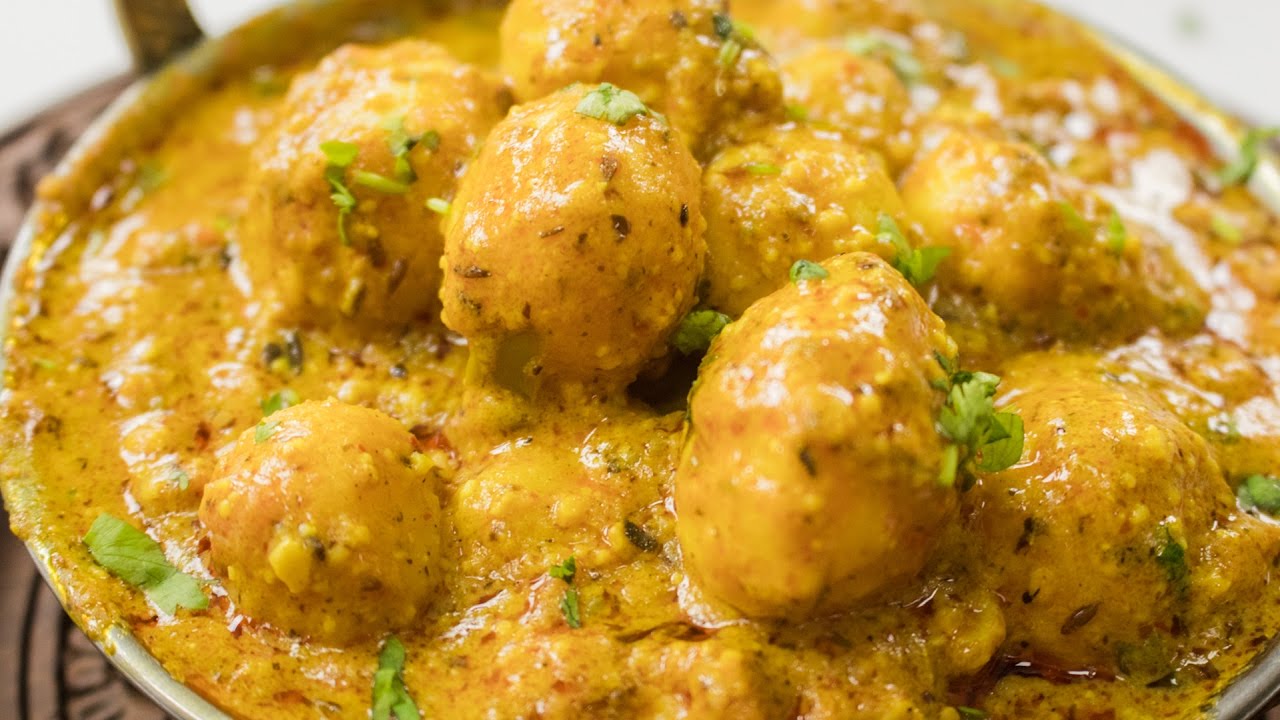
A special preparation of baby potatoes cooked in spicy yogurt sauce, Dum Aloo, is usually ordered by vegetarians. Where to eat: It is easy to source and is available in most restaurants, such as Nawab's Kitchen in Srinagar.
5. Kashmiri Kahwa
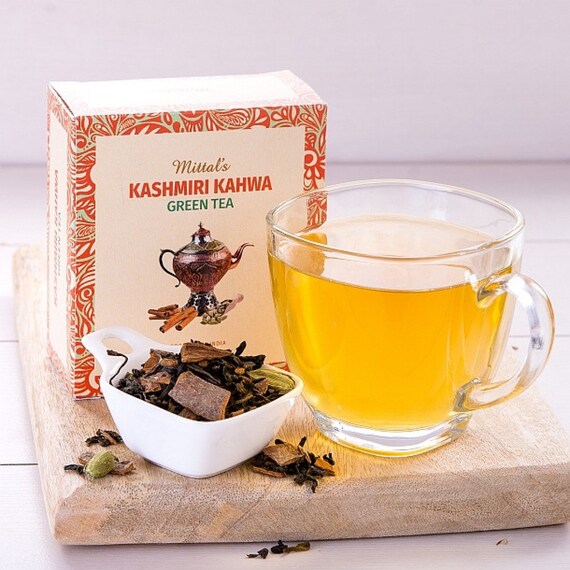
This is a green tea blended with spices and almonds, a warm tea known as Kahwa. Where to drink: It is found in the Srinagar Valley, which is the original. We recommend it under the name of Pahlwan's Tea House.
6. Paneer Chaman
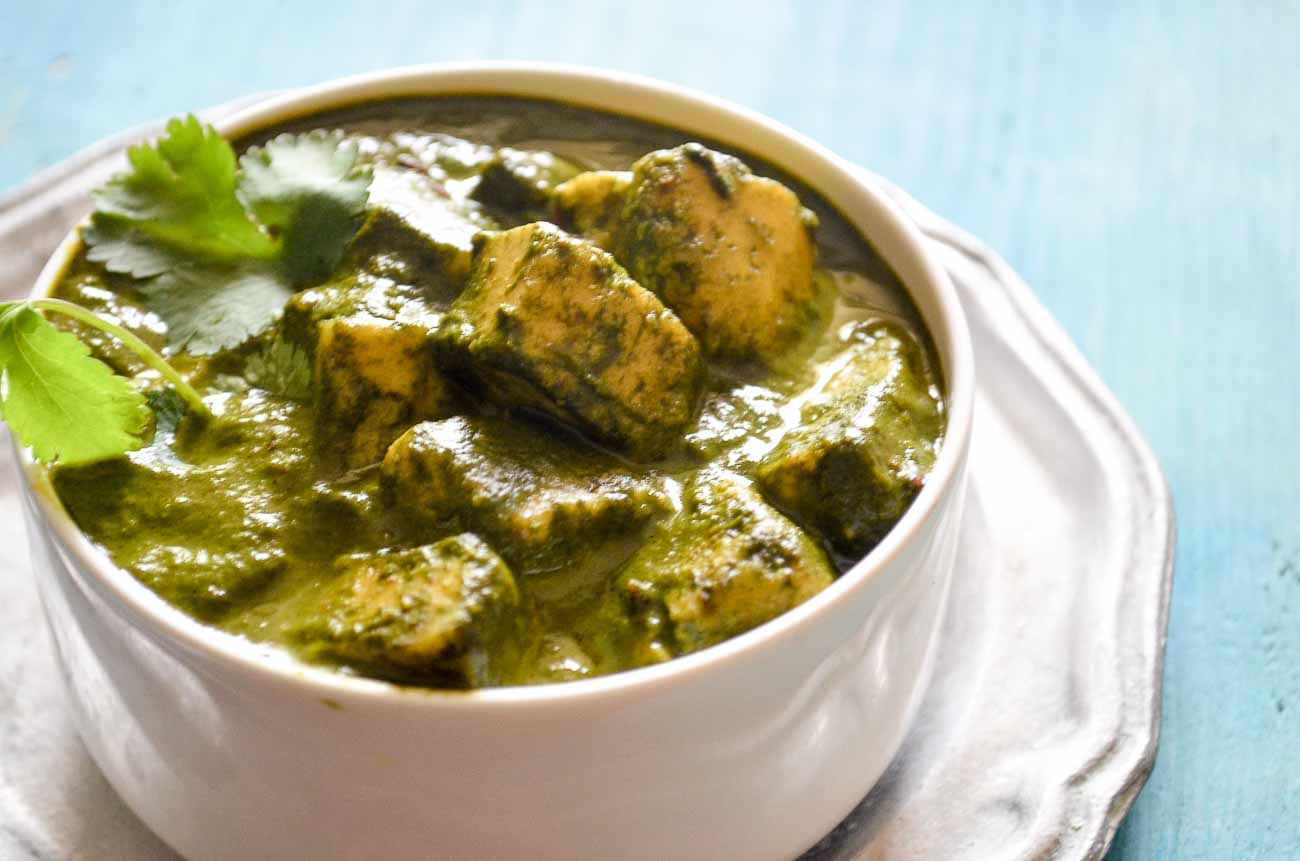
This spicy dish, prepared with spices and fresh cream, is much preferred by vegetarians as it has paneer. Where to eat: Paneer Chaman was on the menu at Shawarma Palace, which is in Srinagar.
7. Kashmiri Naan
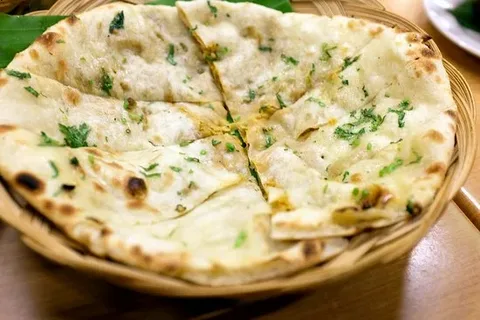
This is another bread recipe prepared from stuffed bread with nuts and dried fruits; it is best served with other foods. Where to eat: Kashmir Bakery is the place to find freshly baked, delicious Kashmiri Naan.
8. Wazwan
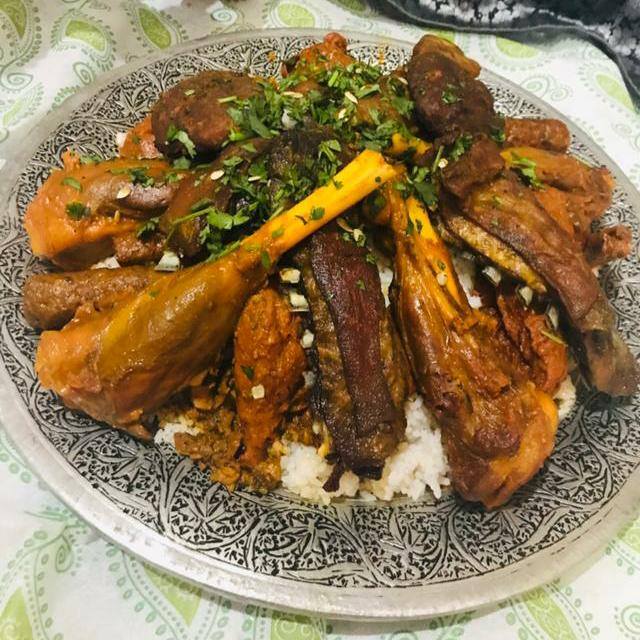
The only other meal that can be recommended to really 'see' and 'taste' Kashmir is Wazwan, a traditional multi-course meal using several preparations. The best thing about having Wazwan served on thick metal plates is the royal feel accompanying the food. Where to eat: Savor Wazwan at Kashmiri Wazwan in Srinagar.
Where To Shop in Kashmir
Kashmir is an important shopping paradise with beautiful handicrafts, textiles, and other specialties. Lal Chowk in Srinagar is a very popular market area.
A lot of activity and crowds can be witnessed there, and one can see traditional Kashmiri products like shawls, handicrafts, special Kashmiri dresses, etc.

In the same breath, as mentioned, Dal Gate Market, near Dal Lake, has superb money souvenirs like Pashmina shawls and saffron, as well as spices from the area.
There are local markets where you can buy handmade woollen garments, jewellery, and wooden handicrafts to get the flavour of Kashmir in Pahalgam. Thus, winter wear and the original Kashmiri handicrafts are available for shopping against the beautiful mountains in Gulmarg.
Many specialized shops across the area and within specialized outlets sell original handmade products such as woven carpets, pure Pashmina scarves, and beautifully crafted wooden ornaments.
A large number of shops and outlets engage in the selling of other products like the suzani embroidered dresses and frocks, which are traditional Kashmiri garments, apart from the woollen clothes one can find Anantnag, Bat Maley, Khanyar Market, Nawazbagan, Shooperian Market, and Nehru Garden Market are the biggest markets for the sale of the real Kashmiri handicraft.
People should also visit bakeries to try traditional spices such as Bakarkhani and the famous Kashmiri cookies. They should also purchase spices such as original Kashmiri saffron and other spices. The Kashmir Haat, a government-run emporium in Srinagar and a market that includes artisans' products, offers various handicrafts, shawls, and Pashmina products.
